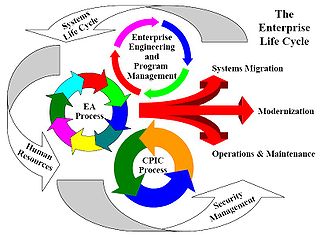
The Zachman Framework is an enterprise ontology and is a fundamental structure for enterprise architecture which provides a formal and structured way of viewing and defining an enterprise. The ontology is a two dimensional classification schema that reflects the intersection between two historical classifications. The first are primitive interrogatives: What, How, When, Who, Where, and Why. The second is derived from the philosophical concept of reification, the transformation of an abstract idea into an instantiation. The Zachman Framework reification transformations are: identification, definition, representation, specification, configuration and instantiation.
Enterprise architecture (EA) is a business function concerned with the structures and behaviors of a business, especially business roles and processes that create and use business data. By international consensus, Enterprise Architecture has been defined as "a well-defined practice for conducting enterprise analysis, design, planning, and implementation, using a comprehensive approach at all times, for the successful development and execution of strategy. Enterprise architecture applies architecture principles and practices to guide organizations through the business, information, process, and technology changes necessary to execute their strategies. These practices utilize the various aspects of an enterprise to identify, motivate, and achieve these changes."

The Department of Defense Architecture Framework (DoDAF) is an architecture framework for the United States Department of Defense (DoD) that provides visualization infrastructure for specific stakeholders concerns through viewpoints organized by various views. These views are artifacts for visualizing, understanding, and assimilating the broad scope and complexities of an architecture description through tabular, structural, behavioral, ontological, pictorial, temporal, graphical, probabilistic, or alternative conceptual means. The current release is DoDAF 2.02.
A federal enterprise architecture framework (FEAF) is the U.S. reference enterprise architecture of a federal government. It provides a common approach for the integration of strategic, business and technology management as part of organization design and performance improvement.

An enterprise architecture framework defines how to create and use an enterprise architecture. An architecture framework provides principles and practices for creating and using the architecture description of a system. It structures architects' thinking by dividing the architecture description into domains, layers, or views, and offers models - typically matrices and diagrams - for documenting each view. This allows for making systemic design decisions on all the components of the system and making long-term decisions around new design requirements, sustainability, and support.

Enterprise modelling is the abstract representation, description and definition of the structure, processes, information and resources of an identifiable business, government body, or other large organization.
Enterprise systems engineering (ESE) is the discipline that applies systems engineering to the design of an enterprise. As a discipline, it includes a body of knowledge, principles, and processes tailored to the design of enterprise systems.

John A. Zachman is an American business and IT consultant, early pioneer of enterprise architecture, chief executive officer of Zachman International, and originator of the Zachman Framework.

In the business sector, business architecture is a discipline that "represents holistic, multidimensional business views of: capabilities, end‐to‐end value delivery, information, and organizational structure; and the relationships among these business views and strategies, products, policies, initiatives, and stakeholders."
In information systems, applications architecture or application architecture is one of several architecture domains that form the pillars of an enterprise architecture (EA).

Enterprise life cycle (ELC) in enterprise architecture is the dynamic, iterative process of changing the enterprise over time by incorporating new business processes, new technology, and new capabilities, as well as maintenance, disposition and disposal of existing elements of the enterprise.

A view model or viewpoints framework in systems engineering, software engineering, and enterprise engineering is a framework which defines a coherent set of views to be used in the construction of a system architecture, software architecture, or enterprise architecture. A view is a representation of a whole system from the perspective of a related set of concerns.

Treasury Enterprise Architecture Framework (TEAF) was an enterprise architecture framework for treasury, based on the Zachman Framework. It was developed by the US Department of the Treasury and published in July 2000. May 2012 this framework has been subsumed by evolving Federal Enterprise Architecture Policy as documented in "The Common Approach to Federal Enterprise Architecture".

FDIC Enterprise Architecture Framework was the enterprise architecture framework of the United States Federal Deposit Insurance Corporation (FDIC). A lot of the current article is about the enterprise architecture framework developed around 2005, and currently anno 2011 out-of-date.

Enterprise architecture planning (EAP) in enterprise architecture is the planning process of defining architectures for the use of information in support of the business and the plan for implementing those architectures.

NIST Enterprise Architecture Model is a late-1980s reference model for enterprise architecture. It defines an enterprise architecture by the interrelationship between an enterprise's business, information, and technology environments.

The Treasury Information System Architecture Framework (TISAF) is an early 1990s Enterprise Architecture framework to assist US Treasury Bureaus to develop their Enterprise Information System Architectures (EISAs).
Capability management is the approach to the management of an organization, typically a business organization or firm, based on the "theory of the firm" as a collection of capabilities that may be exercised to earn revenues in the marketplace and compete with other firms in the industry. Capability management seeks to manage the stock of capabilities within the firm to ensure its position in the industry and its ongoing profitability and survival.

Dragon1 EA Method (Dragon1) is an open method for Visual Enterprise Architecture and also an Enterprise Architecture Framework. Dragon1 covers the development of a variety of architectures, such as enterprise, governance, business, information and technical architecture. It also covers solution architecture, reference architectures and security architecture or Human Capital Architecture (HCA).
The history of business architecture has its origins in the 1980s. In the next decades business architecture has developed into a discipline of "cross-organizational design of the business as a whole" closely related to enterprise architecture. The concept of business architecture has been proposed as a blueprint of the enterprise, as a business strategy, and also as the representation of a business design.












